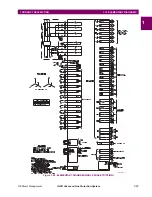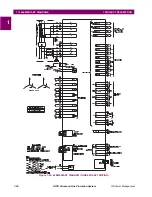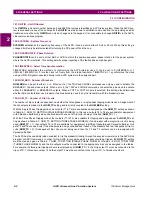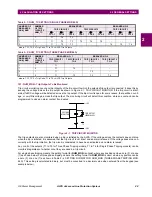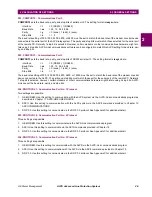
GE Power Management
ALPS Advanced Line Protection System
1-43
1 PRODUCT DESCRIPTION
1.10 OUT-OF-STEP TRIPPING (OPTIONAL)
1
lower two inputs to AND62. AND62 is therefore controlled by TLOS1, which, in turn is controlled by the OUTER char-
acteristic.
3.
The swing now enters the INNER characteristic. One input to AND63 is provided by TLOS2, the second by the INNER.
If the swing impedance remains inside the INNER characteristic for the pickup setting of TLOS3, TLOS3 provides one
input to AND64. At this point the decision to trip has been made and sealed in. The out-of-step tripping output will be
provided immediately if Protection Setting 1703: TRIPIN_OUT = IN.
4.
The swing now leaves the INNER characteristic (traveling in either direction), but remains inside the OUTER charac-
teristic. One input to AND64 is provided by TLOS3, a second input is supplied by the OUTER, the third input is ener-
gized by NOT62 through OR64. If the output from AND64 lasts for the pickup setting of TLOS4, TL64 operates and
seals in. The output of TLOS4 also provides one input of AND65.
5.
If Protection Setting 1703: TRIPIN_OUT = OUT, tripping is not initiated until the swing has passed through the OUTER
characteristic for the second time. When the OUTER resets, the second input of AND65 is supplied by NOT63.
AND65, through OR65, picks up the out-of-step tripping relay, OST. This output lasts for 50 milliseconds (three cycles
at 60 Hz) after the OUTER resets, which is the dropout time of TLOS1.
1.10.4 TWO-CHARACTERISTIC OPERATION
Operation with two characteristics instead of three (Protection Setting 1702: NUMBRCHAR = 2) is essentially the same as
described above, except that the MIDDLE characteristic and TLOS2 are taken out of the circuit. Only the OUTER and
INNER characteristics are involved in the two characteristic mode of operation.
1.10.5 OUT-OF-STEP OSCILLOGRAPHY CAPTURE
The Out-of-Step Tripping option also includes an out-of-step oscillography feature. The OS data file contains the real and
imaginary components of the phase currents and voltages, sampled once per cycle for 180 cycles (60 pre-trigger samples
and 120 post-trigger samples are stored). Data is stored whenever an out-of-step block (OSB) or an out-of-step trip (OST)
condition is detected. If both an OSB and OST are detected, the data is stored based on the OST operation. Only one OS
data file is stored in the ALPS. Once the data is captured, it will not be overwritten until it is retrieved from the ALPS, or
cleared by an OS data reset Action command.























